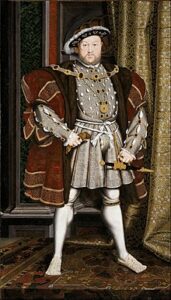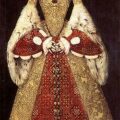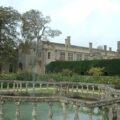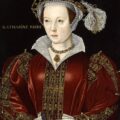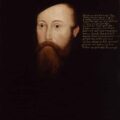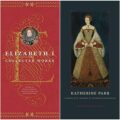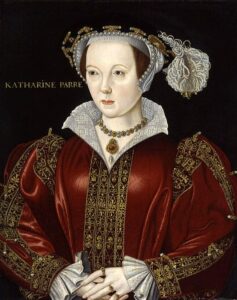
Catherine Parr and Thomas Seymour: The Early Years
In her book “Catherine Parr”, Elizabeth Norton writes of how during the last few months of her second husband’s (Lord Latimer) life in 1543 Catherine was in love with Thomas Seymour, the fourth son of Sir John Seymour and Margery Wentworth, and the brother of the late Jane Seymour, Henry VIII’s third wife. Thomas Seymour had been Henry VIII’s ambassador to the King of the Roman and it was on his return to England in January 1543 that he met Catherine.
While is has been suggested that Seymour was nothing but a gold digger, Elizabeth Norton points out that in 1543 Catherine Parr “was no great catch”, being the widow, or nearly widow, of “a mere baron”. It appears that Seymour was attracted to Catherine because she was intelligent and attractive, not because of her money. We do not know much of this first relationship but we do have the letter that Catherine wrote to Seymour after Henry’s death in 1547, where she talks of their previous relationship:-
“I would not have you think that this mine honest goodwill towards you to proceed of any sudden motion of passion; for, as truly as God is God, my mind was fully bent, the other time I was at liberty, to marry you before any man I know.”
In other words, Catherine’s love was as true in 1547 as it had been in 1543 when she first wanted to marry Seymour. So, why did they not marry 4 years earlier? The answer is Henry VIII.
Henry VIII: The Spanner in the Works
Henry VIII had been devastated by his fifth wife’s betrayal in 1541 and had shut himself away, but by 1543 he was ready to consider remarrying. One problem was that after the fall of Catherine Howard the King had passed a law making it treason for a woman who was not a virgin to marry the King. Hmmm…this rather narrowed the King’s choices! But, as Elizabeth Norton points out, the sixth wife could be a widow, a woman who would not be expected to be a virgin, a woman who had lawfully given up her virginity to another man. Norton quotes the “Chronicle of Henry VIII” which reports Henry VIII as saying to his council:-
“Gentlemen, I desire company, but I have had more than enough of taking young wives, and I am now resolved to marry a widow”
and what better widow than the young, attractive and intelligent Catherine Parr who was a member of his own daughter’s household, a woman he had met when visiting Mary.
In February 1543, Chapuys was reporting Henry’s frequent visits to his daughter Mary and it seems that his daughter was not the only attraction, a member of Mary’s household had caught the King’s eye! Unfortunately, Catherine was in love with another man, Thomas Seymour, but since when did the King let another man stand in the way?!
Although Catherine showed the King quite plainly that she was not interested, Henry VIII had never taken “no” for an answer and so appointed his rival, Seymour, as ambassador to the Netherlands, a post which would mean him leaving England and Catherine. In the Spring of 1543, shortly after Lord Latimer’s death, it is thought that the King proposed marriage to Catherine who answered “it were better to be your mistress than your wife.” Rather than being angered or offended by this answer, Henry simply increased the pressure and Catherine realised that she had no choice. Norton writes of how Catherine prayed for guidance and became convinced that it was God’s will that she should marry the King. She put her feelings for Seymour to one side and agreed to marry her King.
I do not intend to go into details of Catherine’s marriage to the King, but whilst it is clear that their relationship was no great passion or love match, it is clear that the couple were fond of each other. Henry called Catherine his “sweetheart” and “Kate”, and Catherine became fond of the King, and his children, and enjoyed debating religion with her new husband. The marriage worked and even withstood the plotting of those who sought to get rid of her, as they had with Anne Boleyn.
Catherine Parr and Thomas Seymour: Second Time Around
Henry VIII died on the 28th of January 1547 and rather than being Regent to her young stepson, Edward VI, Catherine found herself completely excluded from power. While she was getting used to her new status as the dowager queen, there were rumours flying round that Thomas Seymour, in his ambition, was looking to raise himself through a royal wife, either Mary or Elizabeth. His interest in Mary is mentioned in a report from the Imperial Ambassador, Van Der Delft, and his interest in Elizabeth is proved by correspondence from February 1547 where Seymour writes to Elizabeth:-
“I have so much respect for you my Princess, that I dare not tell you of the fire which consumes me, and the impatience with which I yearn to show you my devotion. If it is my good fortune to inspire in you feelings of kindness, and you will consent to a marriage you may assure yourself of having made the happiness of a man who will adore you till death.”
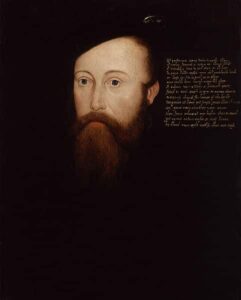
Elizabeth replied, stating her surprise and refusing Seymour’s proposal due to her young age and the fact that she was mourning her father.
Elizabeth Norton writes of how it is not known whether these letters are genuine but the official charges brought against Seymour two years later in 1549 state that he sought to marry Elizabeth before his marriage to Catherine Parr, so he must have shown some interest in Elizabeth at this time.
Whatever the ins and outs of Thomas’s interest in Henry’s daughter, it is clear from correspondence between Seymour and Catherine Parr that their previous love was reawakened shortly after the King’s death and in one of her letters Catherine even signed herself as “your humble, true and loving wyff during her lyf”. To avoid gossip, it appears that the couple would meet in the gardens of Catherine’s house at Chelsea and that Seymour would then stay the night. By day, Catherine was a mourning royal widow, by night she was Seymour’s lover. Finally, she had her man, she was with the man she truly loved.
As I mentioned earlier, it is not known exactly when the couple became betrothed and even when they got married, due to the fact that the couple wanted to keep their relationship quiet because of the King’s recent death. It is clear, however, that they married in haste:-
“he maryed the late Quene so sone after the late Kynge’s deathe that if she had conceived straight after, it shulde have bene a great doubte whither the childe borne shuld have bene accompted the late kinges or yours [Seymour’s]” (words from the later charges brought against Seymour, quoted in “Catherine Parr” by Elizabeth Norton.)
The couple’s haste upset Catherine’s stepdaughter Mary but Seymour was clever when it came to handling his nephew, King Edward VI, he visited Edward and pretended that they had not yet married and that he was asking the King’s consent to marry Catherine, and even managed to convince the boy that it was Edward’s idea! Edward then wrote to his stepmother asking her to consider marrying his uncle and Catherine replied that she would indeed heed her stepson’s advice! After rumours about Catherine’s lack of mourning clothes and her relationship with Seymour, the couple finally went public in late June 1547, angering both Mary and Seymour’s brother, the Protector. Elizabeth, however, seemed to accept her stepmother’s marriage and was pleased to live with the couple at Chelsea.
Marriage to Seymour changed Catherine’s life. She was finally with the man she loved but their marriage was frowned upon and she found herself being snubbed at court and not being given the respect that a dowager queen should command. The Duchess of Somerset, the Protector’s wife, looked down her nose at Catherine and was outspoken in her denigration of Catherine’s status and then there was the issue of Catherine’s jewels. Catherine had kept her collection of jewels in the Tower of London for safekeeping and although some of them had been given to her by the King, there were many pieces that Catherine had inherited from her mother and there was also her wedding ring from her marriage to the King. When Catherine sought to take possession of her jewels after her marriage to Seymour, Protector Somerset informed her that she had no claim to them and that they were the property of the Crown. Catherine never did get her jewels.
So, Catherine was angry, humiliated and powerless, but at least she had her man, didn’t she?
Find out in Part Two!
Source
- “Catherine Parr” by Elizabeth Norton
